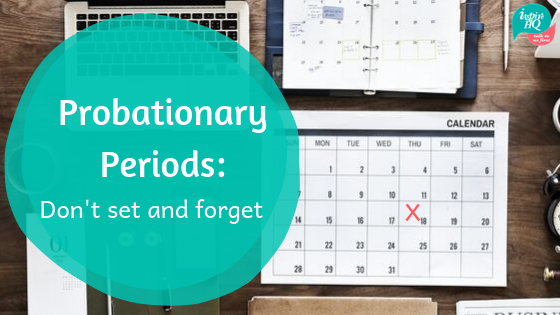An employee’s probationary period is not the employer’s “get out of jail free card” to terminate employment. However, many businesses recruit their new employee, include a probationary period in their contract and then take a set and forget approach to it. It’s not until the day before the probationary period is due to end or sometimes even weeks after the period has ceased that the employer thinks this relationship isn’t working out; I want to terminate the employee’s employment.
I have heard from job seekers that their employment was terminated at the end of their probationary period however throughout that period they received absolutely no feedback at all about their performance and if they were doing a good job or not. I’ve also received calls from businesses who have suddenly decided they want to terminate employment the day or week before the probationary period ends or a couple of weeks after but haven’t provided any feedback throughout the probationary period. It’s like one day they have woken up and decided the employee is not performing or meeting expectations.
The probationary period is the period of time the employer can use to assess if the employee is suitable for the role and the business. Employers can use this period of time to their advantage to help set their new employee up for success. Instead some businesses take the approach that this is the period of time to weed out the not so good employees instead of taking the approach of helping them succeed in the business.
The chances of finding an employee that seamlessly transitions into your business and exceeds your performance expectations without any feedback, direction or guidance on what success looks like or understanding of how you do things in your business, is rare. Effectively managing a probationary period means regular discussions (formal and informal), regular feedback and clear goals and objectives for the employee to achieve at various stages of their employment. Managing a probationary period takes time and effort and unfortunately all too often I am told by an employer “I’ve been busy” or “I got caught up and I haven’t had a chance to catch up with employee to provide feedback”
The problem with not managing the probationary period is that this is the period of employment that sets the tone for the rest of the employer – employee relationship. The behaviour you walk past today during the probationary period is the behaviour you accept. If your new employee doesn’t know that behaviour is not how you do things in your business they will keep behaving or performing to that standard or in that way. Nipping it in the bud – addressing it early will be much easier than trying to change the behaviour or performance 12 months into the relationship.
To get the most out of a probationary period and to help set your new employee up for success, here are our top tips for effectively managing a probationary period:
- Get the position description right. Does it accurately reflect the requirements of the role and the outcomes required? If you used it for the recruitment process, don’t file it away. The Position Description should form the basis of your probationary review discussions.
- Set and document progress milestones. What do you want the employee to be able to competently perform after week 1, month 1, month 2 etc. These should be discussed and reviewed regularly so the employee knows how they are tracking.
- Schedule regular meetings or catch ups to review progress, performance and provide feedback. By scheduling them, they are in the diary and hopefully won’t get overlooked or missed because you got busy.
- Communicate, communicate, communicate. Then communicate some more. Your new employee is learning and taking in lots of new information which can be overwhelming at times. Just because you say something once, don’t assume it has sunk in. If it’s a key message, if it’s how you do things in your business, if it’s an expectation; repeat the message over and over again to reinforce the importance.
- Gather feedback. It’s critical to ensure that you are gathering feedback from the new employee. What’s working, what’s not, how do they like to learn, what do they feel they have mastered, what do they need more assistance with. Probationary discussions should be a two way street and the approach that worked for one employee may not work for the next employee so be prepared to adapt and change the learning process for the individual.
Come the end of the probationary period it should not be a surprise to the employee that you are terminating their employment. If you have managed the probationary period well they will know what’s coming next. They might not like it, but you will have done everything possible to set your new employee up for success.


